BIOLOGY PRACTICAL
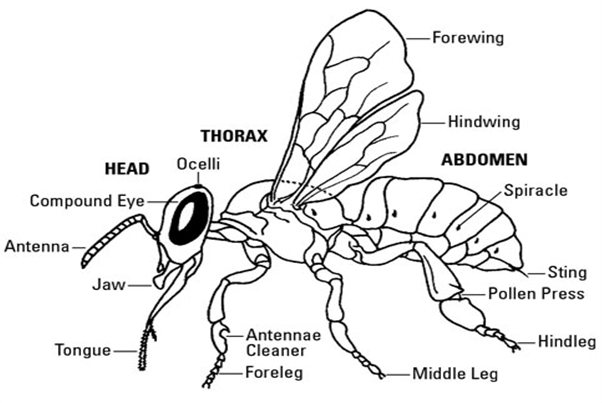
FOOD TEST&CLASSIFICATION
FOOD TESTS
Food test: Are used to determine which nutrients are present in a food specimen.
At this level, we will learn how to test for carbohydrates, proteins, and lipids.
CARBOHYDRATES
Carbohydrates includes: starch, reducing sugar, and non-reducing sugar, that may contains glucose inside of them.
SOURCES OF CARBOHYDRATES .
The following are some of the food that contains nutrients of carbohydrates:
.Maize, Rice, Cassava, Potatoes, Bananas e.t.c
TYPES OF CARBOHYDRATES
There are three types of carbohydrates:
1. MONOSACCHARIDES: These are also known as simple sugar.
Example of monosaccharides are: Glucose, Fructose (fruit sugar), and Galactose (milk sugar).
Characteristics of monosaccharides
-They are sweet.
- They dissolve in water to form sweet solution.
- They are crystalline.
- They are all reducing sugar.
2. DISACCHARIDES: These are formed when two monosaccharides molecules combined.
Example of disaccharides are: maltose, lactose, and sucrose.
Characteristics of disaccharides
- They are sweet.
- They are crystalline.
- They dissolves in water to form sweet solution.
- Some are reducing sugar (maltose and lactose), and some are non-reducing sugar (sucrose).
3. POLYSACCHARIDES: Are formed by condensation involving several monosaccharides.
Example of polysaccharides are: starch, glycogen, chitin, and cellulose.
Characteristics of polysaccharides
- They are not sweet.
- They are insoluble in water.
- They are non-crystalline.
- They form suspensions with water.
- All are non reducing sugar
- Sources of Starch are: Cassava, potatoes, yams, cereals.etc
-Sources of Reducing sugar are: onion, carrot, sugar cane, germinating cereal grains.
- Sources of Non- reducing sugar are: sugar cane, fresh milk, beet root.etc
FUNCTIONS OF CARBOHYDRATES (starch, reducing, and non-reducing sugar).
- Used as a source of energy in the body.
- Regulation of blood glucose in the body.
- Dietary fiber.
- Biological recognition processes.
- Provides flavor and sweeteners. eg sucrose, fructose, and glucose.
- They form important component of cell membrane.
Hypoglycemia and Ketosis ;are diseases caused by lack or inadequate amount of carbohydrates in the body.
Carbohydrates are digested in the body inform of starch.
* Digestion of starch in the alimentary canal takes place at themouth and duodenum.
* At the mouth, the enzyme involved in the digestion of starch is calledsalivary amylase (ptyalin).
* At the duodenum, the enzyme involved in the digestion of starch is calledpancreatic amylase.
* The end- product of digestion of starch isMaltose.
PROTEINS
SOURCES OF PROTEINS
.Egg, Irish potatoes, Beans, Meat, Milk, Fish e.t.c.
FUNCTIONS OF PROTEINS
- Used as a source of energy to the body.
- Used for tissue growth.
- Used for repair the damaged tissue.
- Used in the formation of some tissues. eg hair, nail e.t.c
- They form part of the cell structure.
:Lack of proteins in the body can cause disease calledKwashiorkor.
* The digestion of proteins in the alimentary canal takes place at theStomach and duodenum.
* At the duodenum, the enzyme involved in the digestion of protein is calledTrypsin.
* At the stomach, the enzyme involved in the digestion of protein is calledPepsin.
* The end- product of digestion of protein isPeptides.
LIPIDS
Lipids includes Fats and Oils.
SOURCES OF LIPIDS
.Groundnuts, Coconuts, Avocado, Milk, Meat e.t.c
FUNCTIONS OF LIPIDS
- Used as a sources of energy in the body.
- They protect internal organs like hear, kidney etc.
- Insulate the body against heat loss.
- They assist mechanism of buoyance in marine organisms.
- They are important component of cell membranes.
Excessive amount of lipids in the body can cause Obesity.
Lack of lipids in the body can cause the deficiency of vitamin: A, D, E, K etc
* The digestion of lipids in the alimentary canal takes place at theDuodenum.
* The enzyme involved in the digestion of lipids is calledPancreatic Lipase.
* The end- product of digestion of lipids isFatty acids and Glycerol.
FOOD TEST EXPERIMENT
REAGENTS USED DURING FOOD TEST
.Iodine solution, Benedicts solution, Hydrochloric acid (HCl), Sudan III, Sodium hydroxide (NaOH)/potassium hydroxide(KOH)/ Sodium hydrogen carbonate(NaHCO3), Copper II sulphate.
*Starch can be tasted by using IODINE SOLUTION. If starch present , the colour will appear BLUE-BLACK.
* Reducing sugar can be tasted by using BENEDICT'S SOLUTION. If reducing sugar present, the colour will change from BLUE to GREEN to YELLOW to BRICK RED PRECIPITATE.
* Non- reducing sugar can be tested by using DILUTE HYDROCHLORIC ACID, SODIUM HYDROXIDE(NaOH)/ Potassium hydroxide(KOH)/ Sodium hydrogen carbonate(NaHCO3), and BENEDICTS SOLUTION. If non-reducing sugar present the colour will change from BLUE to GREEN to YELLOW to BRICK RED PRECIPITATES.
* Proteins can be tetsed by using SODIUM HYDROXIDE SOLUTION and COPPER II SULPHATE. If proteins present the colour will appear PURPLE.
*lipids can be tested by using SUDAN III. If lipids present, the RED DROPLETS will appear on the surface.
NOTE:
- The function of hydrochloric acid is to neutralizes disaccharides to monosaccharides.
- The function of Sodium hydrogen carbonate is to hydrolyzes the acid.
PRINCIPLES OF WRITTING FOOD TEST PRACTICAL REPORT:
- It must have four parts: Food tested, Procedure, Observation, and Inference.
- Passive past tens must be used instead of present tens.
- If not guided, the food must be tested in a series of: Starch, Reducing sugar, Non- reducing sugar, Proteins, and the last is Lipids.
- Use specific amount of sample solution and reagents; eg 2mls or two drops and not few mls or few drops.
- It must have a heading at the top.
- If reducing sugar present, no need for testing non- reducing sugar.
FOOD TEST PRACTICAL REPORT
NB:Assume you are provided with solution Z.
| S/NO. | TEST FOR | PROCEDURES | OBSERVATION | INFERENCE |
| 1. | STARCH | 2mls of solution Z was added in a test tube, then 2 drops of Iodine solution were added and shaken the mixture. | -Blue black colour was observed -Yellowish brown iodine was observed | -Starch was present. -Starch was absent. |
| 2. | REDUCING SUGAR | 2mls of solution Z was added in a test tube, then two mls of Benedicts solution was added and boiled for about 2 to 3 minutes. | -Colour changed from: blue to green to yellow to brick red precipitate. - Blue colour of Benedicts solution was retained. | -Reducing sugar was present. Reducing sugar was absent. |
| 3. | NON-REDUCING SUGAR | 2mls of solution Z was put in a test tube, then 1ml of dilute Hydrochloric acid was added and boiled for about 2 to 3 minutes then cooled. After cooled, 2mls of Sodium hydrogen carbonate was added followed by 2mls of Benedicts -solution and boiled for about 2 to 3 minutes. | - Colour changed from: blue to green to yellow to brick red precipitates. -Blue colour of Benedicts solution was retained. | - Non-reducing sugar was present. -Non-reducing sugar was absent. |
| 4. | PROTEIN | 2mls of solution Z was put in a test tube, then 1ml of sodium hydroxide solution was added and shaken followed by 2- drops of Copper two sulphate and shaken the mixture. | - Purple or violet colour was observed . Blue colour of Copper two sulphate was retained. | - Protein was present. -Protein was absent. |
| 5. | LIPIDS | 2mls of solution Z was put in a test tube,then 2-drops of Sudan three was added, shaken the mixture and allowed to settle. Few drops of solution Z was poured on a piece of paper. | - Red droplets was observed on the surface. Red colour of Sudan three was uniformly distributed throughout the solution. Translucent mark appeared on the paper. | - Lipids was present. Lipids was absent. -Lipids was present. |
Sample of questions concerned with food test
* state the role of Hydrochloric acid(HCl) during testing non- reducing sugar
* state the role of Sodium hydrogen cabonateNaHCo3) used at the food test
* State the functions of food that was present during food test
* Whatvare the end-product of digedtion of the following food:
-Starch, proteins, and lipids
* Mention one source of the following food:
- starch, protein, lipids,
* What is deficiency when the body is lacking the following food?
- Lack of protein ...........
- Lack of starch...........
- Lack of lipids...........
* Where in the alimentary canal are the following food digested?
- Starch, protein, lipids
* Which enzymes involved in the digestion of each of the following food?
- Starch is digested by enzymes called......
- Protein is digested by enzymes called.....
- Lipids is digested by enzymes called.........
* In which type of carbohydrate starch is placed?
* In which type of carbohydrate reducing sugar is placed?
* In which type of carbohydrate non- reducing sugar is placed?
CLASSIFICATION
-Classification: is the grouping of organisms based on their similarities and differences.
RANKS OF CLASSIFICATION
-There are seven (7) ranks of classification which are:
1. Kingdom........the highest rank
2. Phylum or division
3. Class
4. Order
5. Family
6. Genus
7. Species..........the lowest rank.
TYPES OF CLASSIFICATION
-There are two types of classification which are:
1.Natural classification:is the grouping of organisms based on many features in common.
2.Artificial classification:is the grouping of organisms based on few features especial observed features.
*TAXONOMY: is the study which deals with the identification, naming and classification of organisms.
*NOMENCLATURE: is the system of giving scientific names to the organisms.
*BINOMIAL NOMENCLATURE: is scientific way of naming organisms where by each organism has one scientific name with two parts, the generic name and the specific name.
MAJOR GROUPS OF LIVING THINGS:
In biology, organisms are classified into five major groups called kingdoms. These groups are:
1. Kingdom monera.eg bacteria
2. Kingdom protoctista.eg amoeba
3. Kingdom fungi.eg mushroom
4. Kingdom plantae.eg maize
5. Kingdom animalia.eg human being
--According to NECTA, different questions of biology practical in classification are based on the last three kingdom: Kingdom fungi,Kingdom plantae, and Kingdom animalia.
KINGDOM FUNGI
-Representative organisms in this kingdom are: mushroom, mucor and yeasts.
General characteristics of kingdom fungi
- They do not have chlorophyll.
- They are eukaryotes.
- They store food as glycogen.
- They are non mobile.
- Are multicellular organisms.
Distinctive characteristics of kingdom fungi
- Their cell wall is made up of chitin.
- They undergo external digestion.
- Their body is made up of mycelium.
- Have no true stem, leaves, or roots.
Phyla of kingdom fungi
1. Phylum Zygomycota.eg rhizopus/ mucor
2. Phylum Basidiomycota.eg mushroom
3. Phylum Ascomycota.eg yeast
* According to this level, only the first two phylum appear to the practical: Zygomycota and Basidiomycota.
1.Phylum Zygomycota:eg rhizopus/ mucor
General features of zgomycota ( rhizopus / mucor).
- They have aseotate hyphae (non- septate).
- They are saprotrophs.
- They reproduce very fast.
- Undergo extracellular digestion.
Economic importance of zygomycota (rhizopus/ mucor).
- They are important in the decomposition of dead organisms.
- They are used in genetic engineering and research.
- They are used in manufacturing of cheese.
- They cause food spoilage.
- They cause diseases both in plants and animals.
Observable features of zygomycota ( rhizopus and mucor).
- They have roots like structure called rhizoids.
- They have spores
- The have hyphae.
Habitat of zygomycota ( rhizopus and mucor)
- They living on dead organic matter.
.Mode of reproduction of zygomycota (rhizopus and mucor)
- They reproduce asexually through spores or sexually through formation of zygosporia.
*Common name of rhizopus/ mucorisblack mold ( bread mold).
*Scientific name of rhizopus/ mucor isRhizopus stolonifer.
ADAPTATIONS OF RHIZOPUS and MUCOR
- Spores are light for easy dispersal by wind.
- They produce a large quantity of spores for the survival of species.
- They reproduce spores sexually and asexually.
- They have rhizoids which assist anchored.
* Classification of rhizopus / mucorto their class level:
- Kingdom;fungi
- Phylum;zygomycota
- Class;mucoromycotina
STRUCTURE OF RHIZOPUS/MUCOR
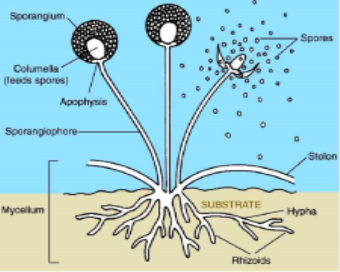
2. Phylum Basidiomycota. eg mushroom.
General characteristics of basidiomycota (mushroom).
- They have septate hyphae.
- They secrete enzymes for external digestion.
- They are saprophytic feeders.
- They grow on rotting wood or soil.
Economic importance of bssidiomycota (mushroom).
- They are source of food to man and other species.
- They can prevent the accumulation of dead matters by decomposing them.
- Some of them are poisonous. eg amanita species
- They are used in genetic engineering and research
Observable features of basidiomycota (mushroom).
- They have gills.
- They have a ring.
- Have cap( pilleus).
- Have stalk.
Habitat of basidiomycota (mushroom).
- They living on dead and decaying organic matter.
Mode of reproduction of basidiomycota (mushroom)
- They reproduce both sexually and asexually by spores formation.
*Common name isMushroom.
*Scientific name of mushroom isAgaricus compestris.
ADAPTATIONS OF MUSHROOM
- Have the ability of secreting enzymes for extracellular digestion.
- Reproduce sexually and asexually to ensure survival.
- Have a cap (pilleus) for protection of basidiospores.
- Some species are poison preventing them from being eaten by predator.
* Classification of mushroom to class level.
- Kingdom; fungi.
- Phylum; basidiomycota.
- Class; agaricomycete
.STRUCTURE OF MUSHROOM
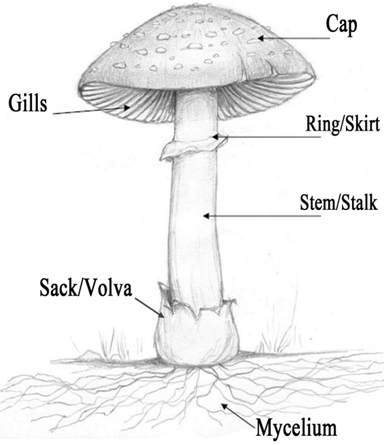
KINGDOM PLANTAE
- Representative organisms in this kingdom are: mosses, fern plant, flowering plants etc.
General characteristics of kingdom plantae
- They are multicellular
- They store food as starch
- They are eukaryotes
- They lack centrioles
- Their cell walls made up of cellulose
- They have chloroplasts
Distinctive features of kingdom plantae
- They have apical growth
- They store carbohydrates inform of starch
- Their cell walls are made up of cellulose
- They have large and permanent vacuole in their cells.
Divisions of kingdom plantae
1. Division Bryophyta. eg liverworts, mosses
2. Division Filicinophyta.eg ferns
3. Division Angiospermatophyta.eg flowering plants
4. Division Coniferophyta.eg conifers
1. DIVISION BRYOPHYTA.eg moss plant
General characteristics of bryophyta (mosses)
- They lack vascular tissues( xylem and phloem).
- They are small in size
- They found in moist areas
- They reproduce both sexually and asexually
- They have false roots, stem, and leaves
- Rhizoids are multicellular
Economic importance of bryophyta (moss plant)
- Help to decompose dead logs.
- Help to prevent soil erosion.
- Provide shelter for insect and small organisms.
- Moss is burned as fuel in some areas.
- Moss occurs as weeds in gardens and other places.
- Moss causing the area to become marshy.
Observable features of moss plant
- Have rhizoids
- Have false roots, stem, and leaves
- Have stalk (seta)
Habitat of moss plant
- Moss plant occurs naturally in damp, shaded and moist areas.
Mode of nutrition of moss plant
- They are autotrophs eukaryotes due to presence of photosynthetic pigment like chlorophyll's
Mode of reproduction of moss plant
- They reproduce both sexually and asexually by means of generation alternations. In this the haploid gametophytes generation produces antheridium and archegonium for sexual reproduction and the sporophyte depends up on formation of the zygote.
* Common name isMoss plant.
* Scientific name of moss isFunaria hygrometrica.
Adaptation of moss plant
- They are autotrophs eukaryotes. This enable them to synthesize their own food substances.
- They are relatively small in size. This signifies them to germinate even in restricted place.
- They posses rhizoids which gives the plant anchorage and absorb water from the soil.
- They posses rigid capsule which stores spores.
- The male gamete is mobile and it can move toward the female gamete for fertilization purposes.
* Classification of moss plant to class level
- Kingdom; plantae
- Division; bryophyta
- Class; musci
STRUCTURE OF MOSS PLANT
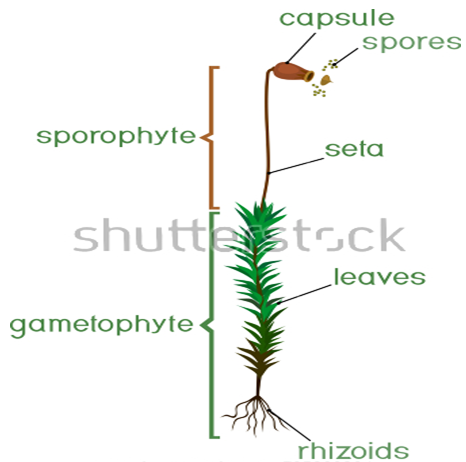
2. DIVISION FILICINOPHYTA( PTERIDOPHYTA).eg fern plant
.General characteristics of filicinophyta (fern plant)
- They have true roots, stem, and leaves.
- They lives in moist place.
- They produce spores on the underside of leaves.
- They have vascular tissues( xylem and phloem).
- Mature leaves have sori on the lower surface.
.Economic importance of filicinophyta (fern plant)
- They are used as ornaments in homes and offices.
- They are used as a food for animal and human
- They are used as a biological fertilizer
- They can be found as weeds in many places.
Observable features of fern plant
- Have leaves.
- Have roots
- Have stem called stalk
Habitat of fern plant
- Fern plants leaves in moist habitats
Mode of nutrition of fern plant
- They are common autotrophs eukaryotes implying that they can synthesize their own food.
Mode of reproduction of fern plant
- They show alternation of generation sporophyte being dominant to gametophyte which is short lived.
* Common name isfern plant.
* Scientific name of fern plant is Dryopteris filixmass.
Adaptations of fern plant
- Roots serve as penetrating organs for vegetation preparation.
- They need both dry and wet conditions through their life cycles.
- The reproductive organs(sori) are well protected by the indusium.
- They posses vascular tissues for conduction.
- They have chlorophyll for photosynthesis.
Classification of fern plants to their class level
- Kingdom; plantae
- Division; filicinophyta
- Class; filicinae
THE STRUCTURE OF FERN PLANT

3. DIVISION ANGIOSPERMATOPHYTA.eg maize plant, bean plant
.General characteristics of angiospermatophyta (flowering plant)
- The reproductive structure is the flower.
- They vary in size and habitats.
- They have well developed vascular tissue.
- They undergo double fertilization.
- After the fertilization the ovary develops into a fruit and ovules into seeds.
Classes of angiospermatophyta
a. Class monocotyledonae.eg maize
b. Class dicotyledonae.eg bean
A. Class monocotyledonae.WG maize plant
General characteristics of monocotyledonae (maize).
- Their seed have single or one cotyledon(seed leaf).
- Their leaves are long with parallel veins.
- The roots are fibrous lacking tape roof.
- The vascular tissue are scattered and random in the stem lacking cambium.
- The floral parts are arranged into 3 to 4 or multiple of 3 and 4.
Economic importance of monocotyledonae ( maize).
- Used as a food for human and other animals.
- They serve habitat for many organisms.
- The produce oxygen and taking cabon dioxide and that serve as a balance for the ecosystem.
- They are the producers.
- They prevent soil erosion and conserving the environment.
Observable feature of maize plant
- Have long leaves with parallel veins.
- They have fibrous roots
- Their floral parts are arranged into 3 to 4 or multiple of 3 to 4.
Habitat of maize plant
- It is an annual plant which grows well in savannah and tropical regions.
Mode of nutrition of maize plant
- It is autotrophic eukaryotes with abundant chlorophyll pigments.
Mode of reproduction of maize plant
- They shows generation alternation in which the sporophyte dominate the gametophyte generation .
Adaptation of monocotyledonae ( maize plant).
- They have extensive roots system for anchorage and absorption.
- Have advanced and elaborated vascular system for translocation.
- Presence of stomata pores for the elimination of excretory wastes.
- They have ability to reproduce sexually without the need for water.
- Presence of cuticle to resist excessive water loss.
* Common name ismaize plant.
* Scientific name of maize isZea mays.
Classification of maize plant to class level
- Kingdom; plantae
- Division; angiospermatophyta
- Class; monocotyledon
STRUCTURE OF MAIZE PLANT.
 |
| STRUCTURE OF MAIZE SEED |
 |
B. Class dicotyledonae.eg bean plant
General characteristics of dicotyledonae (bean plant)
- Their seed have double or two cotyledons(seed leaves).
- They have network of veins in their leaves
- They have vascular tissue arranged in a ringform around the cambium.
- They have tap root system.
- They have cambium for secondary growth.
- Their floral parts are arranged in 4 or 5 or multiple of 4 or 5.
Economic importance of dicotyledonae (bean plant)
- Used as a food for human and other animals.
- They serve habitat for many organisms.
- They are the producers
-They prevent soil erosion and conserving the environment.
- They produce oxygen and taking cabon dioxide and that serve as a balance for the ecosystem.
Observable features of bean plant
- Have network of veins in their leaves.
- They have tap roots system.
- Their floral parts are arranged in 4 or 5 or multiple of 4 or 5.
Habitat of bean plant
- The bean plant is an annual plant which grows in savannah and tropical regions.
Mode of nutrition of bean plant
- The plant is green autotrophs due to its ability of synthesizing food.
Mode of reproduction of bean plant
- They shows generation alternation in which the sporophyte dominate the gametophyte generation .
Adaptations of bean plant
- They have extensive roots system for anchorage and absorption.
- Have advanced and elaborated vascular system for translocation.
- Presence of stomata pores for the elimination of excretory wastes.
- They have ability to reproduce sexually without the need for water.
- Presence of the cuticle to resist excessive water loss.
* Common name isbean plant.
* Scientific name of bean plant isPhaseolus vulgaris.
Classification of bean plant to its class level
- Kingdom; plantae
- Division; angiospermatophyta
- Class; dicotyledonae
STRUCTURE OF BEAN PLANT
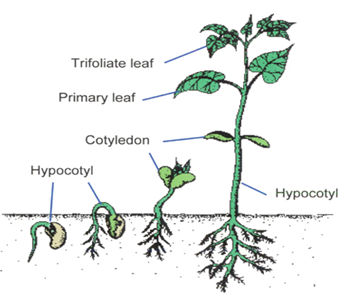 |
STRUCTURE OF BEANS
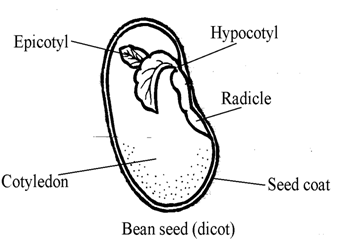 |
THE HALF STRUCTURE OF HIBISCUS FLOWER
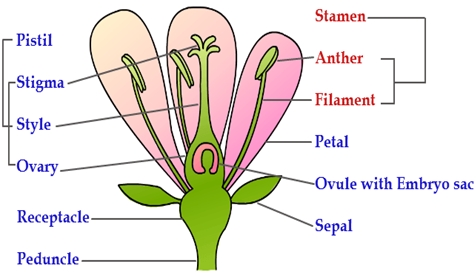 |
The structure of flower that shows male's parts.
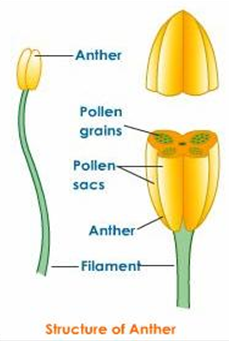 |
The structure of flower that shows female's parts
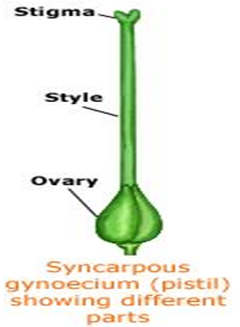 |
Economic importance of flower(hibiscus):
- Used as medicine
- It consist the reproductive parts of plant.
- Used as decoration.
- Assist pollination to take place by atraction of an insects na birds.
- Used as sign of love to the people.
Classification of hibiscus flower:
- Kingdom; plantae
- Division; angiospermatophyta
3. KINGDOM ANIMALIA.eg human being
General characteristics of kingdom animalia
- They are multicellular and eukaryotes.
- They exhibit heterotrophic mode of nutrition.
- They have sensory nervous system.
- They have mainly sexual reproduction.
- They store food in the form of glycogen.
Distinctive features of kingdom animalia
- They have limited growth
- They can locomote
- They have nervous system.
- They show heterotrophic mode of nutrition
- They have skeleton tissues
PHYLUM OF KINGDOM ANIMALIA
A. Phylum platyhelminthesis.eg worms
B. Phylum nematoda.eg ascaris
C. Phylum annelida.eg earthworm
D. Phylum arthropoda.eg insects
E. Phylum chordata.eg fish
*According to this level, we shall deal with the last three phylum that can appear at an exams due to their possibility of availability.
A. PHYLUM ANNELIDA.eg earthworms
General characteristics of annelida (earthworm)
- They have a closed circulatory system.
- The heart is dorsal, has ventrial nervous system.
- They reproduce sexually, fertilization is external.
- They are hermophrodite (two sexes in one organism)
- Have both circular and longitudinal muscles for movement.
Distinctive features of annelida (earthworm)
- Body may have over 100 metameres
- They have hydrostatic skeleton
- The segments are divided by a cross wall called septum
- Excretion is mainly by nephridia
Economic imooratance of annelida (earthworm)
- Their burrows provide natural drainage channels.
- The burrows improve soil aeration
- They increase the depth of topsoil
- The constant passage through the soil reduce the particle to a fine state
- Used in biological study.
- Used as food for some organisms
Adaptation of earthworm to mode of life
- Lives mostly in barrows to avoid dehydration
- They posses chaeta for locomotion
- They are omnivorous mode of feeding, this ensure availability of food throughout so increase chance of survival.
- They have hydrostatic skeleton for support and locomotion
- Similar colour with environment produces comuflage.
Habitat of earthworm
- They lives in moist soil.
Mode of nutrition of earthworm
- They are heterotrophs (omnivorous)
Mode of reproduction of earthworm
- They reproduce sexually by producing egg and sperm at the clitellum.Fertilization is external
* Common name isEarthworm.
* Scientific name of earthworm is
Classification of earthworm to class level
- Kingdom; animalia
- Phylum; annelida
- Class; oligochaeta
.STRUCTURE OF EARTHWORM
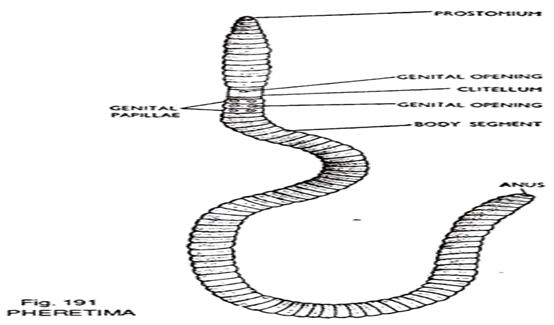 |
B. PHYLUM ARTHROPODA.eg insects
Generalcharacteristics of phylum arthropoda
- Thier have exoskeleton
- They have segmented body
- The body consist of head, thorax and abdomen
- Have antennae
- Have simple or compound eyes
Advantages of exoskeleton
- Provide protection from mechanical or chemical injury.
- Prevent the entry of pathogens.
- It maintains the shape and support the body
- It help in locomotion
Did advantages of exoskeleton
- It is hard and not flexible
- It limit growth and size due to its hardness.
- It is less sensitive
- It is impermeable to gase.i.e doesn't allow free gaseous exchange
Classes of phylum arthropoda
a. Class diplopoda.eg millipede
b. Class chilopoda.eg centipede
c. Class arachnida.eg spider
d. Class crustaceans.eg crab
e. Class insecta.eg bee
a. Class diplopoda.eg millipede
General characteristics of diplopoda( millipede)
- They have segmented body
- They have two pairs of legs in each segment
- Roll into ball when threatened
- Excretion is through malpigian tubules
- The sexes are separate male and female
Adaptation of millipede
- They posses legs for locomotion
- Presence of exoskeleton which protect the internal organs from dessication.
- They secreate a toxic fluid for protection from predators.
- They lives in soil and they are brown blackish in colour gives them camouflage.
- Have one pairvof antenna for sensation
Observable features of millipede
- Have two pairs of legs in each segment
- Have one pair of antennae
- Body divided in many segment
- Have simple eyes
Habitat of millipede
- Thy lives in shady moist soils rich in organic matter.
* Common name ismillipede.
* Scientific name of millipede isLukus terestris.
Classification of millipede to class level
- Kingdom; animalia
- Phylum; arthropods
- Class; diplopoda
THE STRUCTURE OF MILLIPEDE
 |
b. Class chilopoda.eg centipede
General characteristics of chilopoda (centipede)
- Have flattered body
- Have one pair of legs in each segment
- Have pair of poisonous claws to the appendages
- Have a pair of antennae in head region
- Have a pair of mandibles on the mouth part
Observable features of centipede
- Have one pair of legs in each segment
- Have simple eyes
- Have poisonous claws
- Have a pair of antennae
Adaptation of centipede
- Have pair of antennae for sensation
- Have many legs for locomotion
- Have pair of poisonous claws for locomotion
Habitat of centipede
- They lives in sandy soil beneath stone, dry grass areas and barks of trees.
* Common name isCentipede.
* Scientific name of centipede isLithobius froficatus.
Classification of centipede to class level
- Kingdom; animalia
- Phylum; arthropods
- Class; chilopoda
STRUCTURE OF CENTIPEDE
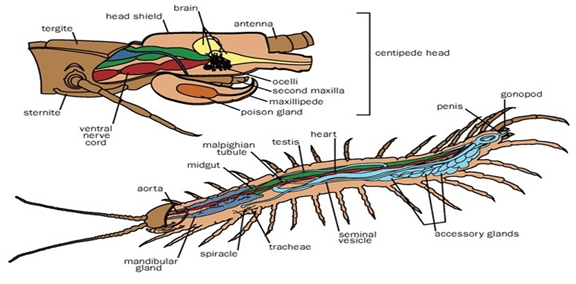 |
c. Class arachnida.eg spider, scorpion, ticks
General characteristics of arachnida(spider,scorpion, tucks)
- They have four pairs of legs
- The body is divided in two regions i.e the cephalothorax and abdomen
- Gesous exchange is by book lungs or trachea system
- Some members have poisonous claws
- Have a simple eyes
Observable features of spider, scorpion and ticks
- Have four pair of legs
- Have simple eyse
- Body divided into two regions
- Have poisonous sting
Adaptations of spider, scorpion, and ticks
- Have legs for locomotion
- Have simple eyse for sight
- Have poisonous sting for protection
Habitat of spider, scorpion, and ticks
- They are terrestrial organisms lives in rocks, roof of the walls and in the soil
Classification of spider, scorpion, and ticks to class level
- Kingdom; animalia
- Phylum; arthropods
- Class; arachnida
THE STRUCTURE OF SCORPION
 |
TICK
STRUCTURE OF SPIDER
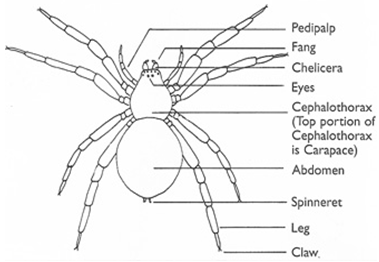 |
d. Class crustaceans.eg crab
General characteristics of crustaceans( crab)
- Have exoskeleton
- Respiratory is by gills
- Have a pair of compound eyes
- Have four pairs of legs
- The body is divided into two main parts.i.e cephalothorax and abdomen
- sexes separate
Observable features of crustaceans (crab)
- Have four pairs of legs
- Have compound eyes
- Have exoskeleton
- The body is divided into two parts
Adaptations of crab
- Have legs for locomotion
- Have compound eyes for maximum sight
- Have exoskeleton for internal protection
Habitat of crab
- They lives in water( aquatic habitat)
* Common name isCrab.
* Scientific name of crab isCrcinus maenas.
Classification of crab to class level
- Kingdom; animalia
- Phylum; arthropods
- Class; crustaceans
THE STRUCTURE OF CRAB
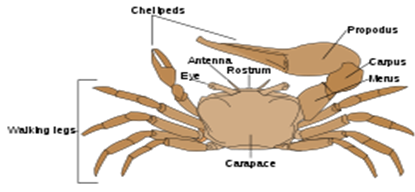 |
e. Class insects.eg housefly.mosquito.cockroach
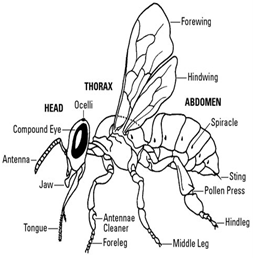 |
General characteristics of insecta( housefly, bee, mosquito, and cockroach)
- Body is divided into three main parts.i.e head, thorax, and abdomen
- Have one pair of antennae
- Gesous exchange by trachea
- Have a compound eyes
- Have three pairs of jointed legs
- Some have developed wings
Observable features of housefly, bee, mosquito, cockroach, and grasshopper
- Have one pair of antennae
- Have jointed legs
- Have pair of wings
- Have compound eyes
- Body divided into three parts
Adaptations of bee, housefly, cockroach, grasshopper, and mosquito
- Have antennae for sensation
- Have legs for locomotion
- Have wings for flying
Bee Housefly.
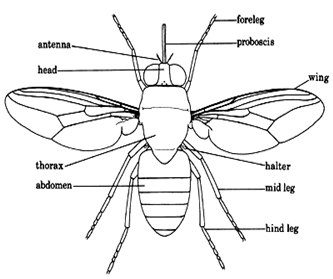 |
Have compound eys for maximum sighting
- Have abdomen for reproduction and respiration
Habitat of bee, housefly, mosquito, cockroach, grasshopper
- They lives in freshly water and terrestrial habitats
Classification of bee, housefly, cockroach, mosquito, and grasshopper to class level
- Kingdom; animalia
- Phylum; arthropods
- Class; insecta
Grasshopper
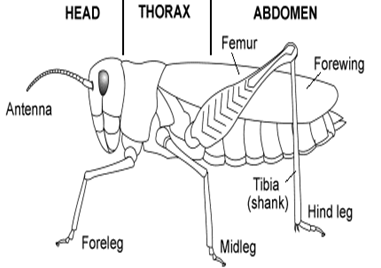 |
Cockroaches
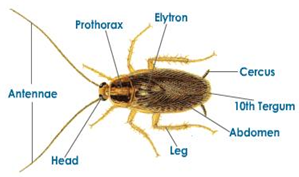 |
Economic importance of bee, housefly, mosquito, cockroach, butterfly and grasshopper
- Acts as agent of pollination.eg bee
- Causative agent of diseases.eg mosquito
- Used in biological study
- Source of food.eg grasshopper
- Used for decoration.eg butterfly
C. PHYLUM CHORDATA.eg fish,
General characteristics of chordata
- Posses notochord
- Presence of nerve cord
- Presence of visceral cleft
- Have ventral heart
Classes of chordata
a. Class chondrichthyes.eg shark
b. Class osteichthyes.eg tilapia
c. Class amphibia.eg frog
d. Class reptilia.eg snake
e. Class aves.eg bird
f. Class mammali.eg bat
a. Class osteichthyes.eg tilapia
General characteristics of osteichthyes( tilapia)
- They have terminal mouth.
- Have a pair of eyes and nostrils
- Scales are cycloid pointing backwards and overlapping
- Posses a homocoecal tail fin at the posterial part
- They have two chambered heart
- They have terminal mouth with homocoecal (equal) tail
Adaptations of tilapia
- Have tail for swimming
- Have gills for gesous exchange
- Have pair of eyes and nostrils for sensitivity
- Cycloid scales pointed backward to support movement during swimming
- Posses swim bladder for buoyancy maintainance
Observable features of tilapia
- Have eyes, and terminal mouth
- Have tail
- Have gills
- Have cycloid scales
- Have fins
Habitat of tilapia
- They are living in every type of water (aquatic organism)
Classification of tilapia to its class level
- Kingdom; animalia
-Phylum; chordata
-Class; osteichthyes
STRUCTURE OF TILAPIA FISH
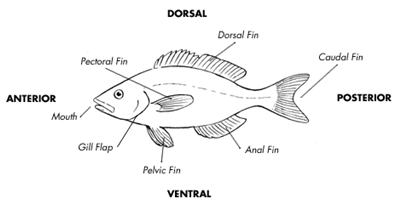 |
b. Class amphibia.eg frog
General characteristics of amphibia (frog and toad)
- The skin is moist and slippery to touch.
- The hind limbs are long and stronger
- The legs are webbed with five digit toes
- The fore limbs are short
- They appear mottled green with dark brown colour.
Adaptations of frog and taod
- With jumping and hopping, they are very fast in locomotion
- The hind limbs are long, muscular and strong for jumping and hopping
- Webbed feet support in swimming
- Have galnds that secrete a milky substance so as to keep away predators
- Have ability to hebernate and search for food in night time.
Habitat of frog
- They are found normally in damp situations onbgrass near water, damp ditches and swimming in ponds or streams.
* Common name isfrog.
* Scientific name of frog isRana temporaria.
Classification of frog to class level
- Kingdom; animalia
- Phylum; chordata
- Class; amphibia
STRUCTURE OF FROG
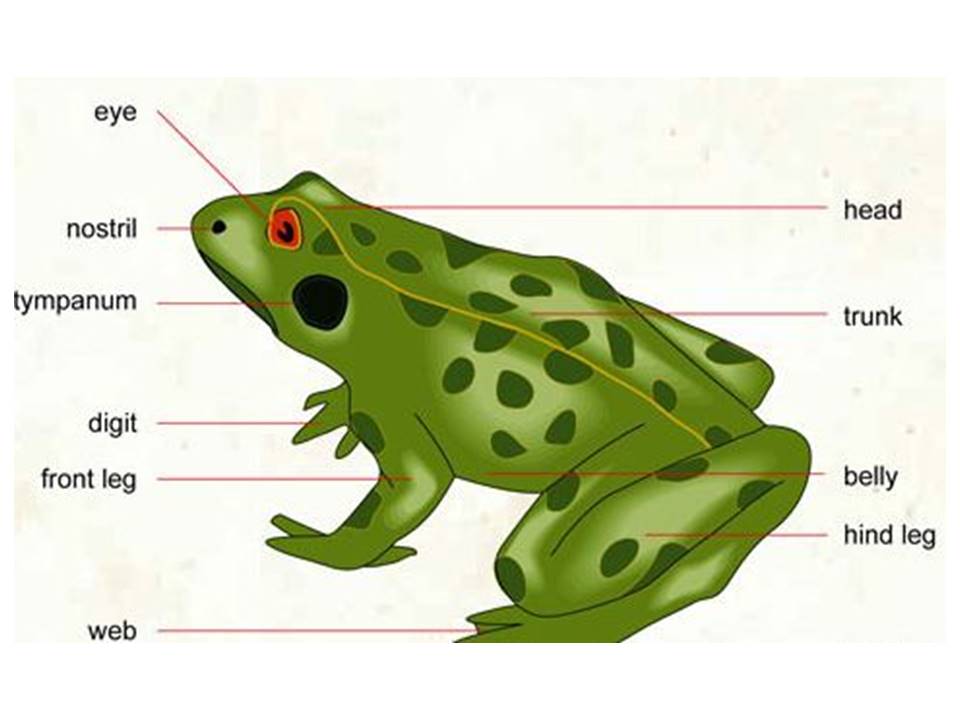 |
c. Class reptilia.eg snake, chameleo, totoe, crocodile.
General characteristics of reptilia(lizard, snake, crocodile,)
- They have dry scaly skin
- Internal fertilization and the eggs are amniotic
- Respiration by lungs only
- Have four chambered heart except the crocodile is completely four chambered heart
- They secrete nitrogenous wastes inform of uric acid
Adaptations of reptilia (snake, crocodile, lizard, camelion)
- Are webbed between toes, aids swimming in water (crocodile)
- Streamed lined body enables easy penetration in water
- Have toes with claws to dig and climb
- Nostrils present for smell
- Produce large number of eggs and protected stiky slimy jelly
Habitat of reptilian
- Most lives in terrestrial ( lizard, snake, tortoes, chameleon), and some lives in aquatic habitat (crocodile, snake, tortoes).
Classification of snake, crocodile, chameleon, tortoes, lizard
- Kingdom; animalia
- Phylum; chordata
- Class; reptilia
STRUCTURE OF LIZARD
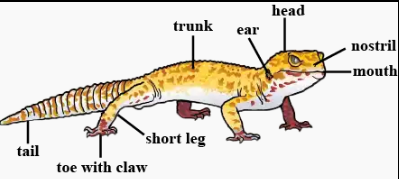 |
d. Class aves.eg bird
General characteristics of aves (bird)
- The fore limbs are modified into wings
- The mouth is modified into a horny beaks
- They have scaly legs and claws on the digits
- They have four chambered heart
- Body coveted with feathers
.Adaptations of aves( birds)
- Body is coverd with feathers for insulation and flight
- The fore limbs are modified into wings for flight
- The body is stream lined to reduce air resistance
- They have hollow bones to keep weight to its minimum for efficient flight
- Internal fertilization increase chance of survival
.Observable features of pigeon (bird)
- Have wings
- Have two hind limbs
- Have feathers
- Have beak mouth
- Have claws in their fingers
Habitat of pigeon( bird)
They lives in almost every part of the world. They inhabit forests such as rainforests, temperate deciduous forests, swamp forests and arboreal forests.
Classification of pigeon( birds) to class level
- Kingdom; animalia
- Phylum; chordata
- Class; aves
Pigeon
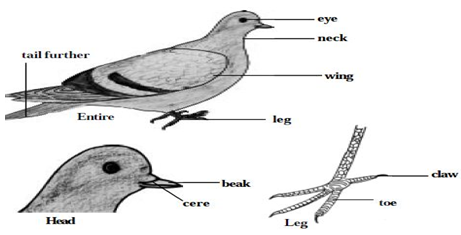 |
e. Class mammalia.eg rat, bat, human being etc.
.General characteristics of mammalian( rat, bat, human being)
- Have mammary glands
- Body coverd by hairs
- Have heterodont teeth
- Have diaphragm
- Have four chambered heart
- Have sweat glands
Adaptations of mammalian(rat, bat, human being,etc.)
- Heterodont dentition a variety of teeth for variety of purpose
- Hairs and glands helps in maintaining body temperature
- Have internal fertilization hence increase chance of survival
- Have well developed blood circulatory system
- Have nervous and hormonal coordination
.Habitat of mammalian (bat, tat....)
- Most of them lives in terrestrial habitat,,and some lives in aquatic habitat
Mode of nutrition of mammalian
-They are heterotrophs due to the lack of chloroplasts
Mode of reproduction of mammalian
They reproduce sexually, they have internal fertilization
Classification of rat, bat NAD human being to class level
- Kingdom; animalia
- Phylum; chordata
- Class; mammalian
RAT.
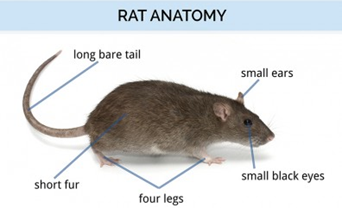 |
Economic importance of mammalian( rat, bat....)
- They are direct source of food. eg cow, rat...
- They are used in biological studies.eg rat
- They are used as guards and detection of drugs.eg dog
- They are used as biological control of pests.eg cat
- They are used for transportation purpose.eg horse
SAMPLE OF QUESTIONS CONCERNED WITH CLASSIFICATION:
NB:assume you are provided with specimen Z that is aBEE.
* What is the common name of specimen Z?.
* What is scientific name of specimen Z?.
* Mention four observable features of specimen Z.
* In which kingdom specimen Z is placed?.
* Outline three features that makes specimen Z to fit in kingdom you mentioned above.
* In which class specimen Z is placed?.
* Classify specimen Z into its class level.
* State the habitat of specimen Z.
* What is the mode of reproduction of specimen Z?.
* Outline four adaptations of specimen Z to its mode of life.
* Listdown five economic importance of specimen Z.
* Outline three characteristics of specimen Z.
* Draw the structure of specimen Z and label it.
Reference books
- L.K. Msaki; Systematics and Classification Mature Publishers Dar es Salaam.
- D.J Taylor, N.P.O.Green, G.W. Stout Biological Science (Third Edition) P.t Ltd Kundli 131028 India 2002 Cambridge University press.
- Kenya Institute of Education Secondary Biology and Biological Science, Second edition published by Kenya literature Bureau, Nairobi, 1992.
- Roberts.M.B.V Biology a Functional Approach, fourth edition. Published by Thomas Nelson publishing Company, London, 1971.
www.learninghubtz.co.tz
Hub App
 For Call,Sms&WhatsApp: 255769929722 / 255754805256
For Call,Sms&WhatsApp: 255769929722 / 255754805256
 For Call,Sms&WhatsApp: 255769929722 / 255754805256
For Call,Sms&WhatsApp: 255769929722 / 255754805256
WHATSAPP US NOW FOR ANY QUERY
App Ya Learning Hub Tanzania






